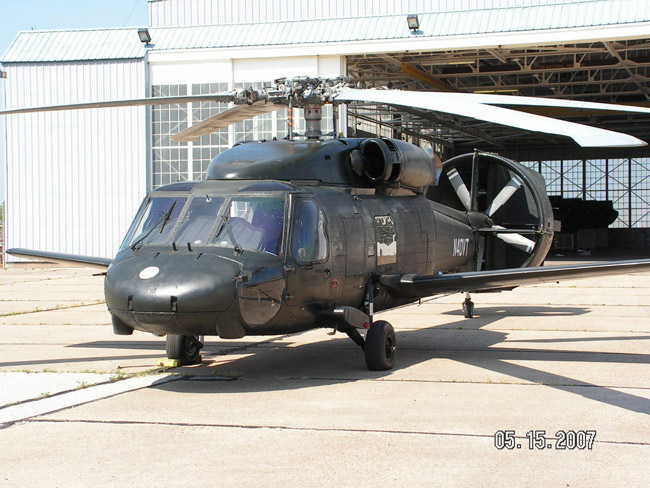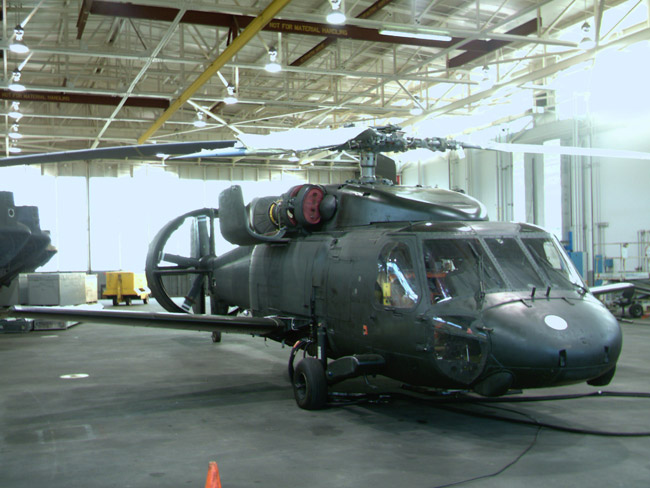Which one is the best jet fighter in the world? You decide! 😉
Category: Military
Sikorsky Piasecki X-49 “Speedhawk” – First Flight in June
Piasecki Aircraft is preparing its X-49 experimental compound helicopter for a first flight before the end of June. [Source]
The modified Sikorsky H-60, with wings and tail-mounted variable-thrust ducted propeller (VTDP), has been moved to Boeing’s Wilmington, Delaware facility for ground and flight testing.


The X-49A “Speedhawk” is an experimental helicopter currently under development. It is the subject of a $US 26.1-million U.S. Navy-sponsored project that consists of a Sikorsky YSH-60F helicopter modified by Piasecki as a testbed to test the “Vectored Thrust Ducted Propeller” (VTDP) system. One YSH-60F will be converted to test the feasibility of VTDP under an advanced technology demonstration program. The YSH-60F is powered by two General Electric T700-GE-401C engines.
The demonstration contract was awarded in October 2000 by the Naval Air Systems Command to Piasecki Aircraft. Piasecki will install a lifting wing with flaperons and a vectored-thrust ducted propeller (VTDP), or “ring tail,” to a U.S. Navy Sikorsky YSH-60F.
The compound helicopter technology that will be added to the YSH-60F was first demonstrated in trials of the Piasecki 16H-1 and 16H-1A in the early 1960’s, when the helicopters were flown at speeds up to 225 mph (360 km/h).
The X-49A YSH-60F flight demonstrator will be updated with a lifting wing taken from an Aerostar FJ-100 business jet. A ring tail will also be added and the helicopter drive train will be modified to accommodate VTDP. Piasecki will conduct integrated tests of the modified drive train at the Navy’s helicopter transmission test facility.
The cockpit controls will be modified with the addition of a manual prop pitch override on the collective for the ring tail. This will be the only visible change to the aircraft’s existing mechanical controls in the cockpit. The other controls needed to operate the compound helicopter’s systems will be integrated into the aircraft’s existing mechanical controls to reduce pilot workload. Weight added to the X-49A YSH-60F will be about 1,600 lb (725 kg). It will have an unrefuelled combat radius of 1,411km following a rolling take-off, and 963km after a vertical take-off, representing a three-fold increase over the standard H-60.
As of 2004 the X-49A YSH-60F/VTDP demonstration program was being transitioned from the U.S. Navy to the U.S. Army.
Videos of the day – Blue Angels F/A-18 Hornet flight
Watch this cool Blue Angels tribute video!
Blue Angels Jet Crashed
A Navy Blue Angels F-18A Hornet jet crashed during an air show Saturday, plunging into a neighborhood of small homes and trailers and killing the pilot, LCDR Kevin Davis.
Witnesses said the planes were flying in formation during the show at the Marine Corps Air Station at about 4 p.m. and one dropped below the trees and crashed, sending up clouds of smoke.
Raymond Voegeli, a plumber, was backing out of a driveway when the plane ripped through a grove of pine trees, dousing his truck in flames and debris. He said wreckage hit “plenty of houses and mobile homes.â€
The Blue Angels were formed in 1946 to promote public interest in naval aviation. Flying F/A-18s painted navy blue, the team performs nationally at air shows, spring through fall, executing highly synchronized aerial acrobatics that bring the fighters within feet of each other at high speed.
Twenty-four Blue Angel pilots have died in accidents, including the one killed Saturday. In 1999, two were killed when an F/A-18 crashed into a stand of pine trees in Georgia as the team practiced for a show.
Profile of killed pilot: http://www.blueangels.navy.mil/off_06.htm
News sources:
http://www.washingtonpost.com/wp-dyn/content/article/2007/04/21/AR2007042100834.html?hpid=sec-nations
http://www.cnn.com/2007/US/04/21/blueangels.crash/index.html
http://www.msnbc.msn.com/id/18248797/
http://www.wsav.com/midatlantic/sav/news.apx.-content-articles-SAV-2007-04-21-0003.html
E-3 Sentry AVACS with special anniversary livery
NATO just painted one of their Boeing E-3A Sentry (707-300) in special 25 years anniversary livery. Very nice livery if you ask me 🙂
(You need to activate Javascript in order to view the photo)
MV-22 Osprey going to Iraq
The Marine Corps announced Friday the V-22 Osprey will see action in Iraq in September when it will be deployed for seven months to help move troops and equipment. Gen. James T. Conway, commandant of the Marine Corps, made the announcement in the Pentagon, in what was called a historic move for the Marines.
The Osprey, manufactured jointly by Textron’s Bell Helicopter in Texas and Boeing in Ridley Township, will be the first tilt-rotor aircraft used by the military. The Osprey can take off and land like a helicopter, tilt its rotors and then fly like an airplane.
The aircraft has been much-maligned for operational test failures over the years, including two fatal flights in 2000, but has the capabilities to fly faster, farther and higher than the CH-46 Sea Knight it is replacing.
Marine Medium Tiltrotor Squadron 263, or VMM-263, which consists of 171 officers and Marines, will operate 10 Ospreys — known as the MV-22 in the Marine Corps.
“The commander had decided this is where the greatest need for this capability is,” said Lt. Col. Scott Fazekas, spokesman for the Marines, explaining the decision to deploy the aircraft to Iraq.
Fazekas said he has not spoken with the pilots who will be flying the V-22 in Iraq, but he has “spoken to several people who have flown the V-22 and they have every confidence in the aircraft.”
The Marines also said VMM-263 could use the Osprey to conduct casualty evacuations or liaison work in a combat environment.
Boeing spokesman Jack Satterfield said the company had expected the aircraft to be used in Iraq because of its improved capabilities.
“I think everybody who’s worked on the program is probably quite proud of the fact that the aircraft is actually going into an operational theatre,” Satterfield said. “I think everybody who has worked on it..ill expect it to do extraordinarily well.”
This will be the very first use in combat for the MV-22 Osprey.
Source zwire.com
